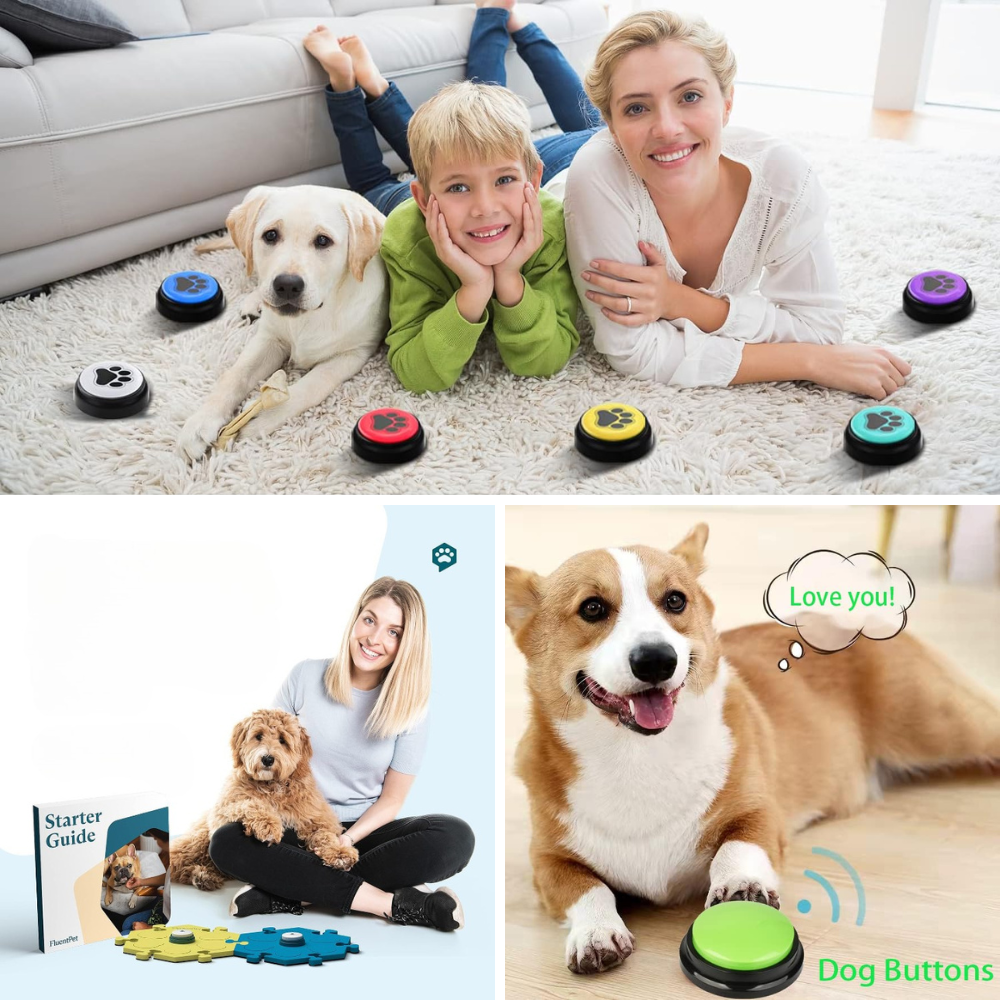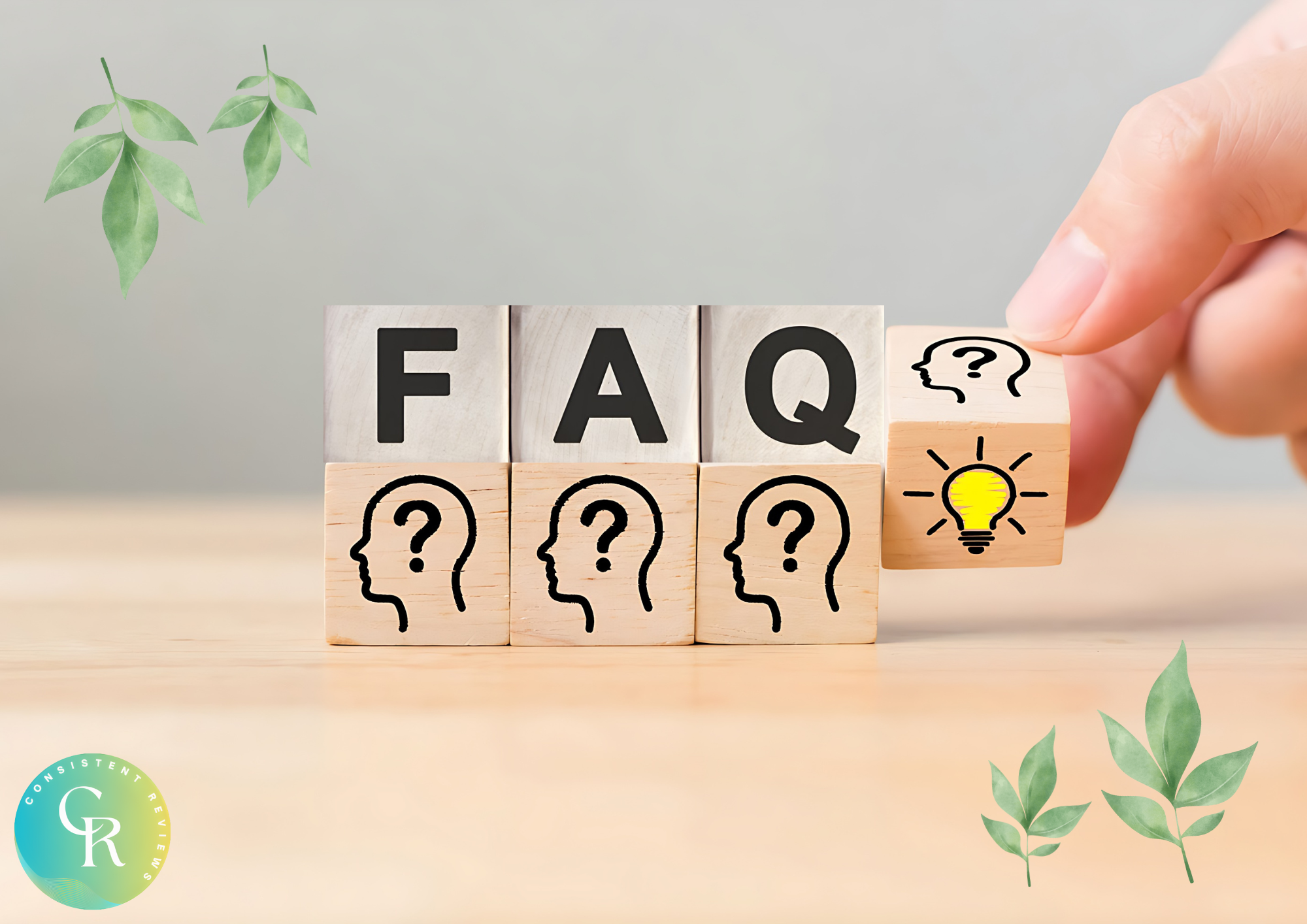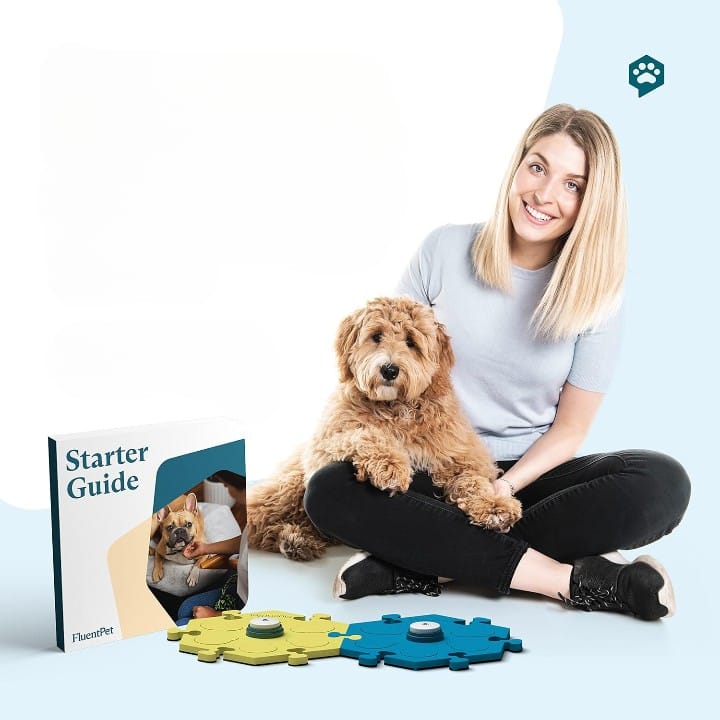Key Takeaways:
- Buttons for dogs to talk are revolutionizing how we communicate with our pets.
- A structured training program is essential for teaching dogs to use talking buttons effectively.
- The talking dog movement is gaining momentum, with success stories inspiring pet parents worldwide.
The idea of a dog pressing a button to say "outside" or "play" might have seemed far-fetched a few years ago, but the talking dog movement is turning this into a reality. With the advent of buttons for dogs to talk, our furry friends are learning to communicate their needs and desires in a way that was once only a dream for pet parents. This comprehensive guide will delve into the world of dog talking buttons, exploring how they work, the training involved, and the impact they're having on human-pet relationships.
The Basics of Dog-Talking Buttons
Talking dog buttons are recordable buttons that, when pressed, play a pre-recorded word or phrase. These buttons are typically made of durable plastic and are designed to withstand the enthusiastic pawing of a dog. They are powered by two AAA batteries and can be recorded with any word that the trainer chooses. The idea is to teach your dog to press the button with their paw or nose to communicate a specific need or desire.
Christina Hunger, a speech therapist, pioneered this method with her dog, and the "Hunger for Words" initiative has since inspired a global community of pet parents. The talking pet starter set usually includes multiple buttons, each representing a different word or phrase, and these buttons are often sold separately so you can customize your dog's vocabulary.
Training Your Dog to Use Talking Buttons
The training program for teaching dogs to use talking buttons involves patience, consistency, and positive reinforcement. Start by choosing a few key phrases that are relevant to your dog's life, such as "food," "play," or "outside." Place the buttons in locations that make sense—for example, the "food" button near where your dog eats and the "play" button where their toys are kept.
Encourage your dog to press the button by guiding their paw or nose to it and rewarding them with the action or item the button represents. Over time, your dog will learn to associate pressing the button with the outcome and will start to communicate independently.
The Science Behind the Buttons
At the Comparative Cognition Lab and other research institutions, scientists are studying how dogs understand and use these buttons. They're exploring the cognitive processes involved when a dog learns to associate a button with its corresponding action or item. The research is shedding light on the capabilities of dogs to understand aspects of human language and communication.
The FluentPet system is one example of a scientifically designed layout that helps dogs and cats learn to communicate. The system includes an activity guide and organizes the buttons into categories using different colors and textures, making it easier for pets to remember and distinguish between the buttons.
Success Stories and the Impact on Pet Communication
The talking dog movement has seen many success stories, with pets learning to express themselves in ways that were previously impossible. Bunny, a Sheepadoodle, has become an internet sensation for her ability to use over 70 buttons to communicate with her owner. These stories are not only heartwarming but also demonstrate the potential for deeper understanding and bonding between pets and their owners.
Pet parents who have embraced this method report a significant change in their relationship with their pets. They find it helpful to understand their pet's needs better, reducing frustration on both sides. The ability to communicate has also opened up new avenues for mental stimulation and enrichment for the pets.
Choosing the Best Dog Buttons for Your Pet
When selecting a dog talking button set, consider factors such as durability, ease of use, and the ability to record clear, distinct sounds. The best dog buttons are those that can withstand repeated use and have a clear, loudspeaker so your dog can hear the recorded phrase when they press the button.
It's also important to choose a set that allows you to expand the number of buttons as your dog learns. Some systems, like the FluentPet system, offer a modular design that lets you connect additional buttons as your dog's vocabulary grows.
Understanding Your Pet's Unique Voice
When we talk about giving our pets a voice, it's not just about the literal sound they make but understanding their unique way of communicating. With buttons for dogs to talk, we're putting the power of speech into their paws, allowing them to express their needs and desires in a way we can understand. Each dog's voice will develop differently, as they discover which buttons to push to say "sit," "play," or "outside." It's a fascinating journey that brings us closer to our canine companions, as we learn to listen to their unique way of 'speaking' through these pet supplies.
As we introduce these buttons organized in a box or a board, we must pay attention to how our dogs interact with them. Some pups may take to the buttons quickly, eagerly pushing them with their nose or paws to get their message across. Others may be more hesitant, requiring gentle encouragement and repetition to understand the connection between the button and the outcome. Observing how your dog uses the buttons to communicate can give you insight into their thought processes and preferences, deepening the bond between you and your pet.
Integrating Feline Friends into the Mix
While the focus has often been on dogs, it's worth noting that our feline friends can also benefit from this technology. Cats are known for their independence, but that doesn't mean they don't have anything to say. By introducing buttons for a cat to talk, we open up a new avenue for them to express themselves. Just like with dogs, training a cat to use buttons involves patience and understanding. Start with simple commands like "food" or "play" and gradually expand their vocabulary as they get more comfortable with the concept.
Cats may require a different approach when it comes to training with buttons. They are often less food-motivated than dogs, so finding the right incentive is key. It could be a favorite toy or a cuddle session that encourages them to push the button. Once they make the connection that pressing the button gets them what they want, they'll be more likely to use it to communicate. It's an exciting development in pet communication, allowing us to hear our cat's voice in a whole new way, and it's a testament to the versatility of these pet supplies in enhancing the lives of various animals.
Setting Up Your Talking Button System
Once you have your talking dog button set, it's time to set it up in your home. Place the buttons in logical locations and ensure they are easily accessible to your dog. For example, the "outside" button could be placed near the door your dog uses to go out.
Organize the buttons in a way that makes sense to your dog, grouping related words. This will help your dog learn the concept of categories and make it easier for them to find the button they want to press.
Incorporating Buttons into Daily Life
To make the most of the talking buttons, incorporate them into your daily routine. Use the buttons yourself to show your dog how they work, pressing the "food" button before you feed them, for example. This repetition and consistency will help your dog understand the connection between the button and the action.
Be patient and celebrate small victories. It may take some time for your dog to get the hang of it, but with persistence, they will start to use the buttons to communicate with you.
Troubleshooting Common Issues
If your dog is having trouble using the buttons, consider whether they are placed in the right location or if the recorded words are clear enough. Sometimes, adjusting the volume or re-recording a word more distinctly can make a big difference.
Also, ensure that the buttons are not too close together, which can confuse. Give each button enough space so your dog can easily press the one they intend to.
Expanding Your Dog's Vocabulary
As your dog becomes more proficient with the buttons, you can start to introduce new words. Add buttons for different types of food, toys, or people they know. You can even teach them phrases like "love you" or "all done" to further enhance your communication.
Remember to introduce new buttons one at a time and associate them with the corresponding action or item to help your dog learn their meaning.
The Role of Consistency and Repetition
Consistency and repetition are key when teaching your dog to use talking buttons. Use the same words and phrases regularly, and encourage your dog to press the buttons by repeating the action or giving them the item associated with the button.
By consistently reinforcing the meaning of each button, your dog will start to form patterns and understand how to communicate their needs effectively.
The Future of Pet Communication
The talking dog movement is just the beginning of a new era in pet communication. As more pet parents and researchers explore the possibilities, we can expect to see advancements in the technology and methods used to teach pets to communicate.
The potential for dogs and other pets to express themselves more fully is an exciting prospect that could transform the way we interact with our animal companions.


How long does it take for a dog to learn to use talking buttons?
The time it takes for a dog to learn to use talking buttons varies depending on the individual dog and the consistency of the training. Some dogs may start using the buttons within a few weeks, while others may take several months to become proficient.
Can any breed of dog learn to use talking buttons?
Yes, any breed of dog can learn to use talking buttons with the right training and motivation. The key is to find what motivates your dog and use that to encourage them to use the buttons.
Are talking buttons suitable for cats or other pets?
While the talking dog movement is primarily focused on dogs, cats, and other pets can also learn to use buttons to communicate. The training principles are similar, but the approach may need to be adjusted to suit the specific needs and behaviors of different types of pets.
Can dogs memorize words?
Yes, dogs can memorize words. They are capable of recognizing and remembering a significant number of words and commands. A Border Collie named Chaser was reported to understand over 1,000 words, the largest known vocabulary of any dog.
Has any dog ever talked?
No, dogs cannot talk in the same way humans do. They lack the physical vocal apparatus needed to produce human speech. However, they can learn to associate certain sounds or words with specific actions or objects and can communicate through barking, whining, growling, and body language.
Why do dogs learn?
Dogs learn for the same reasons humans do - to adapt to their environment, communicate, solve problems, and improve their quality of life. Training and learning also strengthen the bond between a dog and its owner.
What human words do dogs understand?
Most dogs can understand basic command words such as "sit," "stay," "come," "down," "heel," and "no." They can also learn to recognize the names of specific objects (like their toys), people, and other pets. The exact number of words a dog can understand varies depending on training, breed, and individual temperament.
What are kisses in dog language?
In dog language, licking or "kissing" is a form of communication that can signify a variety of things, from affection and submission to a desire for attention or food. It's a natural behavior that dogs use to interact with their pack and their human families.
What is a cute word for a dog?
There are many cute words or nicknames for a dog, such as "pooch," "pup," "furry friend," "fur-baby," or even more personalized names based on their appearance or personality.
Do dogs like dog talk?
Yes, research shows that dogs respond positively to "dog talk" - a high-pitched, slow-tempo way of speaking that's similar to how humans talk to babies. This type of speech can help to engage a dog's attention and may enhance their understanding of certain words or commands.

The use of buttons for dogs to talk is a groundbreaking development in pet communication, offering a new way for dogs to express their needs and desires. With the right training program, durable plastic buttons, and a commitment to consistency, pet parents can teach their dogs to communicate in once unimaginable ways. The talking dog movement is not only enhancing the bond between pets and their owners but also opening up new avenues for understanding animal cognition and language.










